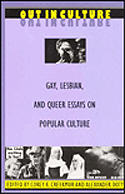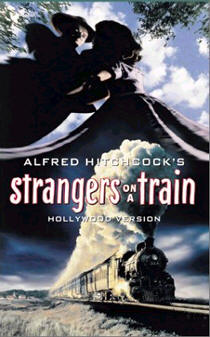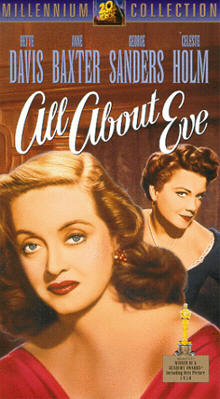 |

 |
|
Gay, Lesbian and Queer Esays on Popular Culture One Institute Press Out in Culture: Gay, Lesbian and Queer Esays on Popular Culture by Corey K. Creekmur and Alexander Doty, Duke University Press, 1995, $23  Of the many anthologies that have been published in the field of gay and lesbian studies, Out In Culture is one of very few to focus specifically on the relationship of gays, lesbians, and queers to popular culture.
Of the many anthologies that have been published in the field of gay and lesbian studies, Out In Culture is one of very few to focus specifically on the relationship of gays, lesbians, and queers to popular culture.
As the title indicates, "[for the writers collected in this anthology, a central issue is how to be 'out in culture': how to occupy a place in mass culture, yet maintain a perspective on it that does not accept its homophobic and heterocentrist definitions, images, and terms of analysis" (2). Toward a greater understanding of this relationship, the editors of the volume have collected essays from a broad range of sources, some highly theoretical, some historical and political, some poetic, and others journalistic. It combines both early foundational contributions to the field and more recent works which illustrate the many advances and shifts in thought throughout the past two decades. As such it seems awkward that the dates of the individual essays have not been provided as a way to chart this evolution of thought. Thus the structure of the book seems awkward at times, leaving the reader to guess as to why a particular essay was placed in a particular section. In addition, the overemphasis in the introduction on camp as a central sensibility of all gay/queer culture runs dangerously close to repeating the androcentric (and heterosexist) mistake of universalizing from the male experience. However, the essays themselves represent a fairly diverse set of perspectives. While not all viewpoints are included (notable exclusions being lesbians of color, issues of bi- and transexuality, and contributions from non-African American people of color), the collection remains a valuable source of important and informative work. The collection opens with two significant early contributions to the field: Robin Wood's 1978 "Responsibilities of a Gay Film Critic" and "Lesbians and Film" (1981), co-authored by Edith Becker, Michelle Citron, Julia Lesage, and B. Ruby Rich. This pair of essays present two very different calls for the same thing: a specifically gay and lesbian criticism of popular culture. Wood's essay is a coming out statement and revision of the author's own earlier work, while the other is an exposure of the suppression of female relationships in general and lesbian sexuality in particular that such a criticism could work to correct. On a more specific level, Chris Straayer's essay "The Hypothetical Lesbian Heroine in Narrative Feature Film" seeks to extend traditional psychoanalytic theories of the gaze in an attempt to identify/locate the structure of lesbian desire in film. Essays by Al LaValley and Alexander Doty look at the reception of texts as a way of investigating the position of gays and lesbians with regard to mass culture. LaValley identifies strains of a gay (male) sensibility in Hollywood films like All About Eve, East of Eden, or Sunset Boulevard, that have acquired gay followings.
Of the remaining four essays in this section, three look at specific texts, while one, Patricia White's "Supporting Character: The Queer Career of Agnes Moorehead" investigates a star's persona to expose the ideological function of the typically desexualized supporting character within heterosexually presumptive Hollywood narratives. Valerie Traub uses the film text of Black Widow to demonstrate "the way binary categories of gender determine in advance our conceptualization not only of gender identity and behavior but erotic positions and practices, and to show how the conflation of gender and erotic desire serves this binary teleology." (117) This film, she asserts, both plays to and confounds these expectations, thereby opening up ideological gaps into which lesbian desire can be read. Following Traub's highly theoretical essay, B. Ruby Rich takes a much more historical and political look at the 1931 German film Maedchen in Uniform, claiming it as a foundational lesbian text by placing it in the context of the German homosexual movement of its time. The section concludes with Corey Creekmur's re-reading of John Ford's My Darling Clementine, in which "Wyatt Earp (Henry Fonda) cruises Doc Holliday (Victor Mature), who responds by buying him a glass of champagne and then asking him out on a date" (167). In pointing out places in the film which are at odds with more traditional genre or auteur criticisms, Creekmur demonstrates the validity, indeed the necessity, of this type of work. The first of two sections dedicated to specific topics is a collection of writings about director Alfred Hitchcock, whose "queerness" (in the many senses of the word) has generated a great deal of critical analysis. Five essays are presented here, four of which are fairly theoretical. The remaining essay, by John Hepworth, comes from a more journalistic viewpoint. Hepworth's piece is an insufficiently supported and somewhat ranting diatribe against not only Hitchcock's homophobia, but also against those critics, including such respected names as Claude Chabrol, Eric Rohmer, and Robin Wood, all of whom he claims refuse to either take notice of or condemn this homophobic stance. While there certainly is evidence in Hitchcock's films in support of the accusation, Hepworth makes against the director, this essay demonstrates his inability to articulate his objections in a productive manner. Significantly, also included in this volume is the letter of response written by Robin Wood in which he successfully both points out the failures and exclusions in Hepworth's article and defends his own critical position. In fact Wood's own look at the same topic "The Murderous Gays: Hitchcock's Homophobia" (taken from his 1989 book Hitchcock's Films Revisited) is positioned immediately after Hepworth's. In it he uses a psychoanalytic framework to explore the homophobia in the films as well as in Hitchcock's own dealings with gay actors.
 Also in this section are Sabrina Barton's look at Hitchcock's Strangers on a Train, "Crisscross," Rhona Berenstein's insightful investigation of the constructions and interactions of the female characters in Rebecca, and Lucretia Knapp's lesbian reading of Marnie.
Though this is by far the most cohesive of the sections of the book, it seems incomplete, particularly in light of the numerous other important works on Hitchcock. One such conspicuous absence is D.A. Miller's highly influential "Anal Rope," without which any collection of essays on Hitchcock would be incomplete.
Also in this section are Sabrina Barton's look at Hitchcock's Strangers on a Train, "Crisscross," Rhona Berenstein's insightful investigation of the constructions and interactions of the female characters in Rebecca, and Lucretia Knapp's lesbian reading of Marnie.
Though this is by far the most cohesive of the sections of the book, it seems incomplete, particularly in light of the numerous other important works on Hitchcock. One such conspicuous absence is D.A. Miller's highly influential "Anal Rope," without which any collection of essays on Hitchcock would be incomplete.
The following section contains essays which take up a range of aspects of popular culture. Michael Moon looks at performance and camp through the underground film work of Jack Smith; Bruce La Bruce analyzes the campy comedy of Pee Wee Herman; Nayland Blake explores the drawings of gay pornographic artist Tom of Finland. Pornography is also the subject of Thomas Waugh's essay "Men's Pornography: Gay vs. Straight," written in the early '80s and reprinted here with a new forward by the author. Jan Zita Grover's excellent discussion of the historical development of media images of people with AIDS (PWAs), originally written in 1989, remains a powerful and informative look into the politics of images. Also looking at the power of the image is the insightful essay by the late Essex Hemphill on television's In Living Color, particularly its "Men on Film" sketch, which features two stereotypical "black queens" as caricatures. After considering a wide range of opinions on the segment, Hemphill, rather than coming to a definitive conclusion on its relative merits (or dangers), issues a call for all disenfranchised groups to come to a greater understanding of the power of the image and to take greater responsibility for both their production and consumption. The second of the two dossier sections of the book looks at popular music and the ways in which gays and lesbians find themselves placed within and in relation to it. Richard Dyer, in the opening essay of this section, argues that disco is more than music; it is also "kinds of dancing, club, fashion, film-in a word, a certain sensibility (407). Dyer both elaborates common arguments against disco (such as its capitalist mode of production) and then proceeds to explore the aspects of it that he sees as relevant, in a positive way, to gay male culture. In "Crossover Dreams," Arlene Stein turns to the subject to the complex relationship between lesbians and popular music. She traces the lesbian presence in music from the roots of "women's music" in the lesbian/feminist movement in the '70s, through the era of androgynous pop stars and into the beginning of the crossover stage (from the marginality of lesbians in "women's music" to the centrality of pop) which she sees in the '90s. However, rather than seeing this as a simple forward progression, Stein complicates it with reference to the paradox of visibility and the potential for appropriation. Michael Musto and Anthony Thomas also take up the question of appropriation, Musto in relation to the figure of Madonna and Thomas with disco. In "Immaculate Connection," Musto provides a fascinating discussion of the complex relationship between Madonna's embrace (exploitation ?) of queerness and the gay community's embrace of her as the quintessential icon. Thomas also focuses on music and appropriation while tracing the influence of African American gays on dance music, particularly disco and retro-disco. The remainder of the essays in the book look into issues of dress and style. Male crossdressing, particularly in the latter half of the 20th century, is addressed by both Mark Thompson and Jeffrey Hilbert in their respective essays. Thompson provides a brief history of the drag queen phenomenon focusing on the Cockettes of the '60s and early '70s as well as the more radical traditions of groups such as the Angels of Light; the Sisters of Perpetual Indulgence; and the late George Harris, known professionally as Hibiscus. Hilbert turns attention to the political stakes in drag, particularly as it exists in the midst of the AIDS crisis. In a striking and poetic essay, the late Marlon Riggs, lost recently to AIDS, explores the complicated and often uncomfortable position of black gay masculinity in contemporary culture. The political implications of the recent popularity of "lesbianism as style" is the subject of Arlene Stein's second contribution to the volume. In "Style Wars and the New Lesbianism" she argues that "when power is at stake, a politics of images is no substitute for a 'politics of substance.' Images are too easily manipulated" (482) The adoption of style without the political impetus behind it, she asserts, amounts to little more than appropriation and commodification, a topic which Danae Clark takes up in the book's final essay. Clark's seminal and often reprinted essay "Commodity Lesbianism" looks at the complexities of identity which emerge in the wake of the acknowedgement of gays and lesbians as a consumer market. She specifically investigates the phenomenon of "gay window advertising," which, as she defines it, exhibits subtle clues as to its pitch to the gay/lesbian audience while still retaining the ability to appeal to a straight audience. While arguably dated from the perspective of 1998, the essay remains essential to any collection of works in gay, lesbian, and queer studies of popular culture. Another significant feature of the book is its bibliography, which identifies resources in the field of "gay, lesbian, and queer studies." The references like the essays contained in the volume are drawn from diverse sources and provide a solid starting point for further resources. Taken as a whole, the anthology is a significant contribution to the important field of queerness in popular culture. Reviewer Lauri Mullens is a Ph.D. candidate in Critical studies in the School of Cinema at the University of Southern California. She is writing her dissertation on the representation of infectious disease in popular culture, with emphasis on the gendered and sexualized nature of these representations. |
 © 1997-2000 BEI
© 1997-2000 BEI
 Doty addresses film and television, gays and lesbians in his discussion, arguing that "[q]ueer readings aren't 'alternative' readings, wishful or willful misreadings, or 'reading too much into things' readings...[but] result from the recognition and articulation of the complex range of queerness that has been in popular culture texts and their audience all along." (84) While LaValley's piece is the older of the two (written in 1985), Doty's is the more well grounded and consistently argued, including a thorough justification of his use of the word "queer."
Doty addresses film and television, gays and lesbians in his discussion, arguing that "[q]ueer readings aren't 'alternative' readings, wishful or willful misreadings, or 'reading too much into things' readings...[but] result from the recognition and articulation of the complex range of queerness that has been in popular culture texts and their audience all along." (84) While LaValley's piece is the older of the two (written in 1985), Doty's is the more well grounded and consistently argued, including a thorough justification of his use of the word "queer."